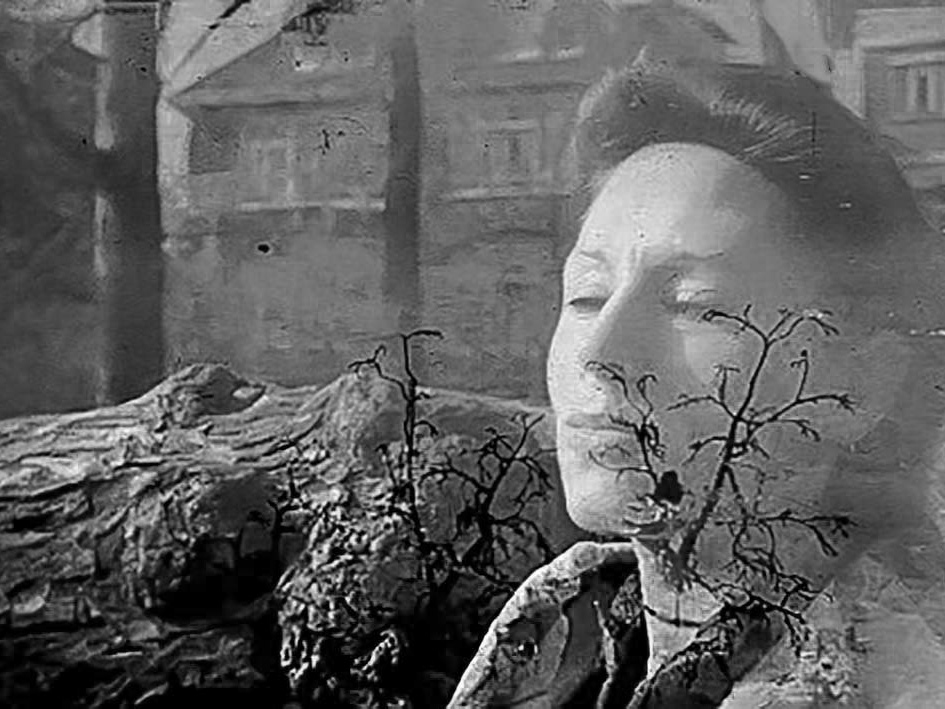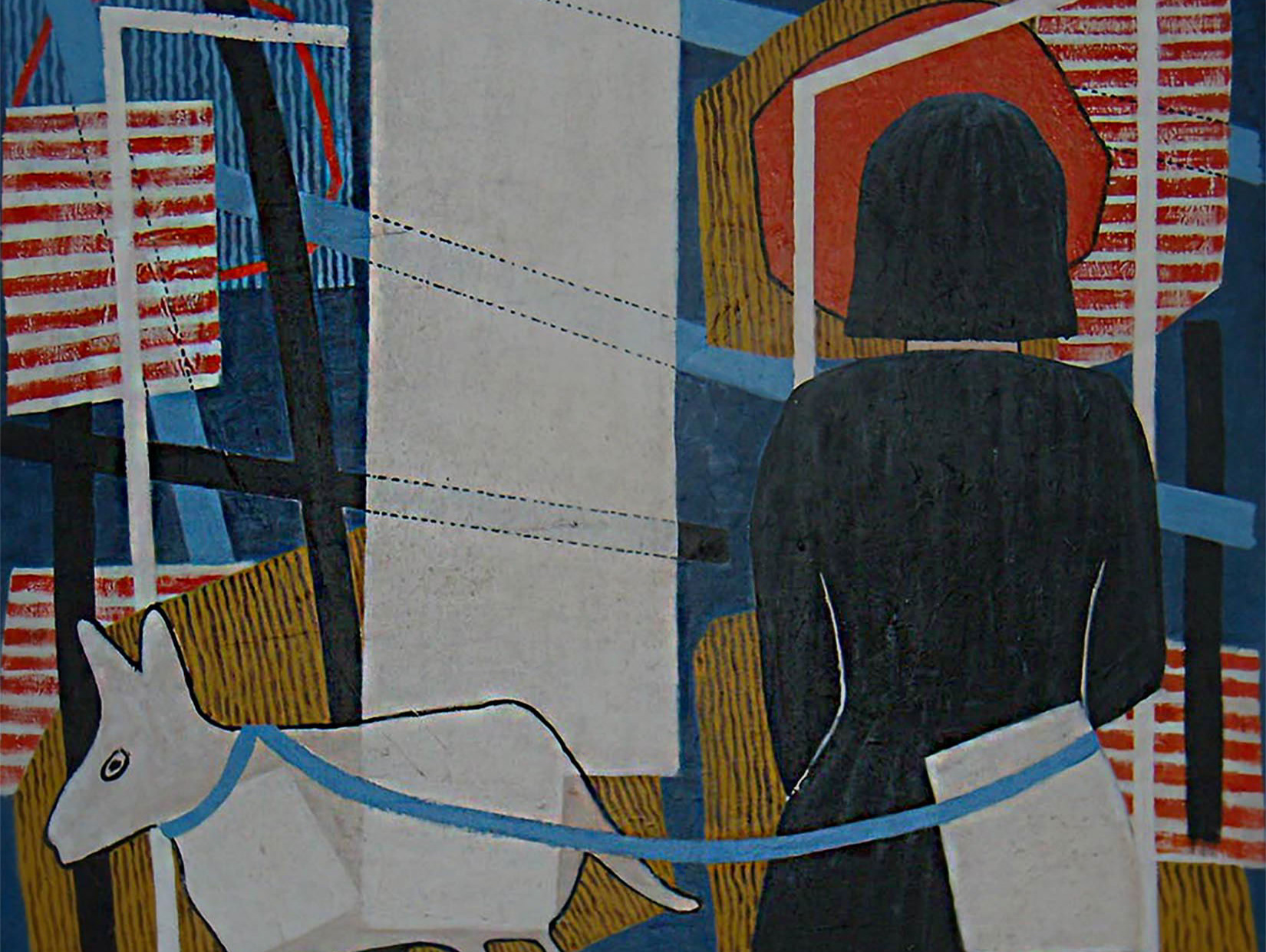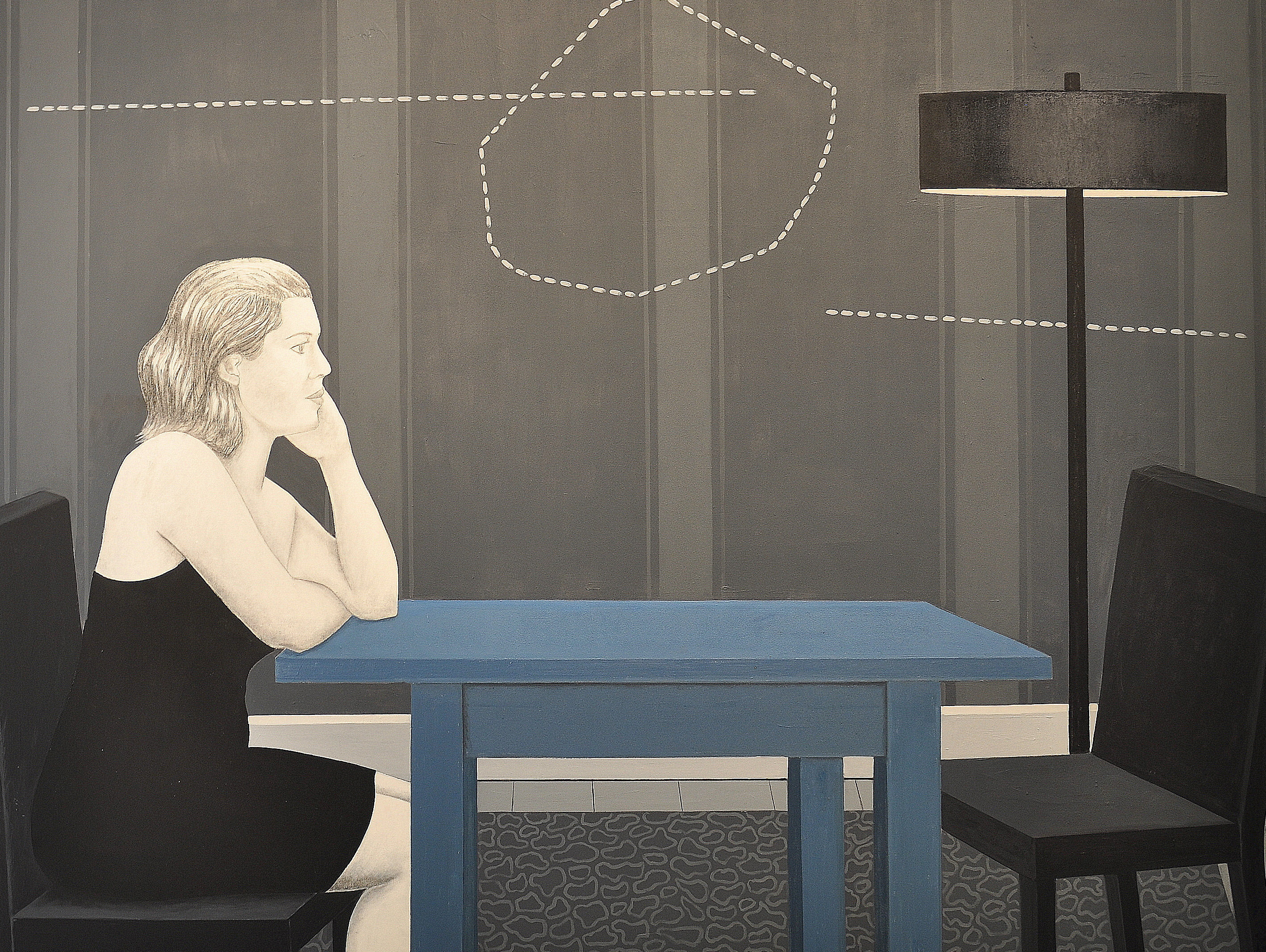CUTOUTS I
2015 . 2016
In 2015, Pintomeira starts the production of a new series entitled "Cutouts". He agglutinated the words from the verb "to cut out" and substantivate the agglutination to the word cutouts. The artist used a distinct mixed media technic, more comprehensive and more elaborated. He paints or draws his shapes, mostly faces, with acrylic or graphite pencil, on a non-assembled canvas. Then, using scissors, he cuts it, randomly, in different pieces. These fragments are, then, ordered on the floor of his studio, until he reached the final composition. All these pieces (canvas), ordered this way, are then glued to the main canvas, now mounted on a wooden grid. In the next phase the glued shapes and the spaces between them are worked with acrylics, using drippings, layers, textures, and lines. The aesthetical composition expresses degradation, destruction, aging, and the vision of a deteriorated mural painting, or ancient frescos ruined by the time or by man’s negligence.
CUTOUTS | mixed media on PVC| 90x90 cm | 2022 | Private Collection
CUTOUTS | mixed media on PVC| 90x90 cm | 2022
CUTOUTS | mixed media on canvas | 180x160x4cm | 2016 | Private Collection
CUTOUTS | mixed media on canvas | 180x160x4cm | 2016
CUTOUTS | mixed media on canvas | 180x160x4cm | 2016
CUTOUTS | mixed media on canvas | 180x160x4cm | 2016
CUTOUTS | mixed media on canvas | 130x130x4cm | 2016
CUTOUTS | mixed media on canvas | 130x130x4cm | 2016
CUTOUTS | mixed media on canvas | 130x130x4cm | 2016
CUTOUTS | mixed media on canvas | 130x130x4cm | 2016
CUTOUTS | mixed media on canvas | 130x130x4cm | 2016
CUTOUTS | mixed media on canvas | 130x130x4cm | 2016
CUTOUTS | mixed media on canvas | 130x130x4cm | 2016
CUTOUTS | mixed media on canvas | 115x115x4cm | 2016 | Private Collection
CUTOUTS | mixed media on canvas | 115x115x4cm | 2016
CUTOUTS | mixed media on canvas | 90x100x4cm | 2016 | Private Collection
CUTOUTS | mixed media on canvas | 130x130x4cm | 2016
CUTOUTS | mixed media on canvas | 130x130x4cm | 2016 | Public Art Collection
CUTOUTS | mixed media on canvas | Diptych | 90x180x4cm | 2016 | Private Collection
CUTOUTS as a metaphor of our time.
Ramón Villares
Professor of Contemporary History
University of Santiago de Compostela
President of the Galician culture council
The use of the word cut-out can be of a great variety. Its use as an artistic technique is closely related to the figure of Henri Matisse, who practiced a sort of “cut & paste” which was really, as he said, a way to “paint with scissors”. However, this technique is also associated to a great variety of activities such as, femur surgery, modification and cleaning of photographs (photoshop), the proposals of the feminine dressing that parades in the fashion catwalks and, naturally, the economical politics applied to nowadays recession and its unavoidable following of cuts regarding salaries and other social wages. It is not the only word which testifies the complexity of the actual society, but it remains clear that “cut-out” designates something that is nowadays happening. It is therefore not coincidentally that it was a painter who best depicted the expression. From this tradition was born the proposal of Pintomeira (Deocriste, Viana do Castelo), who proposed a series of cut-outs as a way to celebrate his golden anniversary as an artist.
Regarding the long artistic trajectory of the author, we come across various phases (steps), conceptually diverse and audacious what concerns the technical level. One of his essential marks is actually the capacity to experiment in order to find new shapes and languages in a panorama as the contemporary painting that is forced to change skin constantly in order to adapt itself to the challenges of other visual art forms as well as migrating to new supports. It is not easy to be an artist nowadays, of material urgencies and shape cannibalism: everything changes at great speed because all is consumed with delight. Considering that poets and visual artists, have the obligation to inform the world where
and even anticipate future problems.
Pintomeira possesses technical expertise, intellectual baggage, knowledge of national and international painting trends and, besides it, a strong will to experiment. And being so, he arrives to this new proposal in his biography, which is the cut-outs series, inspired by the painter’s artwork of Henri Matisse, developed during the last years of his life that recently, was shown in all its glory and amplitude by the prestigious museums, Tate Modern and MOMA. For Matisse, this project was a crepuscular solution; for Pintomeira it is, on the contrary, a new experiment towards the maturity of his artistic trajectory. After inquiring about the surreal or reconciling the figurative art form with the necessity of identity, which marked a good part of his artwork, now he tries to understanding the actual world, in which the fragmentary, the recycled, but also the “cuts” make part of the society’s present debate, of its challenges and fears.
If we take a look at his artworks produced in the past, we observe that Pintomeira oeuvre conjugates with great skill the perspective of the reality with the capacity of transforming it into a metaphor of the society we live in. Therefore, the artworks gathering in this new theme Cut-outs keep the aesthetic and linguistic dosage of his trajectory, feeding from the desire, history and narration. The portraits, their own identity, compose the main themes on which he worked since the seventies. His vision passes through history in a conjunction of iconic references of Art History itself, historical vanguard, pop tendencies and its posterior readings, integrating a contextual construction of the subject and his search to reformulate an identity from painting. We can also interpreting his artwork in a context defined by aesthetical and formal changes of the pictorial derived from the seventies and eighties, flirting with the nineties in a continuous recovery of the painting as field of debate since visual culture, as an update and reflexive channel of the present, in a social and cultural moment, especially active confronting the Portuguese political situation in the first place then global in its ensemble.
In this way, his artwork conciliates references and offers a richness of languages that germinates in the the seventies ambiance. His surrealist series dating back to (1970-1978) compose the gearing of references close to the vocabulary and script wich Bretón related, a style which deepens and elaborates a narrative surrealism, in the line of Dali, Magritte or Paul Delvaux, in a comprehensive understanding of creation in a dimension of the dreams, of the oneiric and the literary. These paintings are works with references to styles and singular periods in the History of Painting – Baroque, Romanticism - and thematic of portraits and landscapes, with naked women, which reserve a final of history identified with the quotidian, with a veiled incertitude. His works keep always a whisper of transfer, of search and following of tendencies, as observed, regarding pop or figuration, in works, sometimes advertising oriented, drinking of the audio-visual culture, of the movies and the iconic.
Those will be the aesthetical foundations that will shape and draw his following productions. Pop culture acquired its main body without forgetting references to new figurations, in the Outlines theme from (1992-1999) and New Line from (1999-2007). The thematic follows with proposals from the social, through portraits drinking from everyday experiences, to a behavioural pattern and family experience. Accentuating styles, the works reviewing lines and profiles, with fields of plain colours, creating a kind of a mosaic or showcases, of compositions occupying all the space with paintings, of areas and figurative resources, and where the corporal reference focuses on faces and bodies, hands and silhouettes, where the perspective nullifies itself and a search of the emblematic is encouraged. In the series Faces from (2003-2010) and, in a more direct way, in Interiors from (2008-2011) and Exteriors from (2011-2012), first appear flat cut, fragmented and sequenced, televisual and urban figures, which correspond to what we use to call the irremediableness of Pop. An attention to what that centralizes the advertising, the iconic, for the construction of a place; and a scenography into which, as in a shop showcase or in a monitor, where the figures repeat themselves representing a happening, a present time moment, but also ephemeral.
In all Pintomeira oeuvre, the vision possesses a transmitting intention, manifests a desire to narrate and fascinate, aspiring to transform into images daily memories. We’re dealing here with the recognition and the rethinking of the past as well as activating a use narrative, of the immediate, without forgetting the poetic side of the trajectory of the time. To this style corresponds the new theme Cut-outs, which registers and synthesize all of these sources and visions integrating his trajectory and repeats a precise technic of the cut, the collage, and the reconstitution of a artwork which acquires a different meaning from the parts constituting it.
However, beyond the technic, which has already an accurate grammar, we can observe in this particular series an interpretation of the present of his own history. The elaboration of character’s narratives, singularized through faces and portraits, is presented from a distant past; from a past that is discovered and met, as a kind of archaeological reconstruction of the painting’s narration. Its execution, based on a construct of retails and paper fragments, resides in a present time but also from a past territory, exhibited now as a reminder of the memory’s dissected parts. This way, it will be women faces, drawn by pencil in a subtle and precise line, focused as in the photographic work and in the hyperrealism, which share composition with abstractions, with blemishes of transparencies and signs of erosion. These are artworks originated by the crossroad of high and low culture, which we could reproduce through the visual imaging culture, without losing the link to realism, as used in photographic series, in portraits and scenography.
Other compositions of Cut-outs have its roots in a past of mural paintings, using the technic of the fresco, as we can observe in the works of the Medieval Art period, linked with architecture, occupying vaults or cloisters, or on the temple walls from ancient cultures, which now as a “proximity” exercise, seem to be recuperated by a narrative making from the process of recuperation, of a restorer or archaeologist, a gesture of a recovering process of the painting and of the own culture. The colour, faces and hands configure the space; it is an insistent reference to eyes, vision, as well as hands, related whit its own physical painting dimension, from the march of the human being, of its tactile identity to beat the time. His works translate the past in a similar logic of writing, from its sources, the places, the memories, the register of events. We see and retain what we remember. This way, the history presents itself as one more page – almost like a photograph - a transparence and a white or blue pigment’s layer, marking a metaphorical past, through the own painting’s filter. These are scenes of a defined past, usual characters, mothers and sons detained in precise chronologies, in a primitivism rooted in an appearance or illusion of the past, while others look like found in our own territory.
Pintomeira composed, in a deliberate way, a fresco of the actual society, through the utilization of a polysemic technique. In case of the arts, this technique favours fragmentation and, at the same time, creates a new aesthetic where everything keeps, constantly, on deconstructing and reconstructing. Visions whether fragmented or repeated that, in spite of everything, help to understand the complexity in which we combine the personal and collective identity with the uncertain and extinguished memory, with this combination of degrees of history layers with an inquisitive look of who is wondering about the future. This is a debate, although being old, never ceased to be modern: to understand the universal, we need to start from practical or, to say it with the words of the poet Miguel Torga, considerating that “the universal is a place without walls.”









